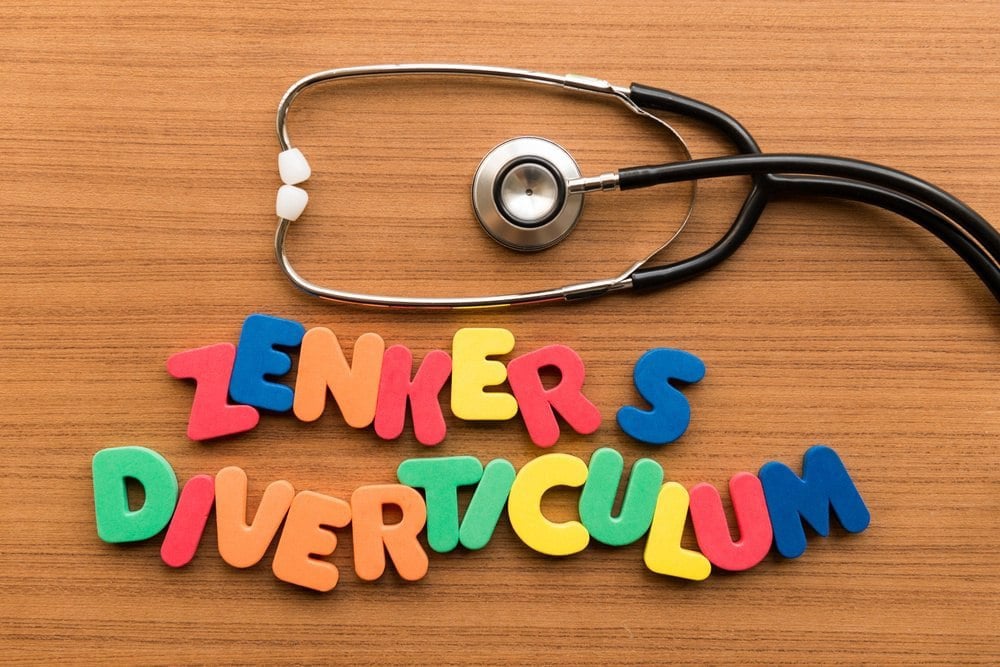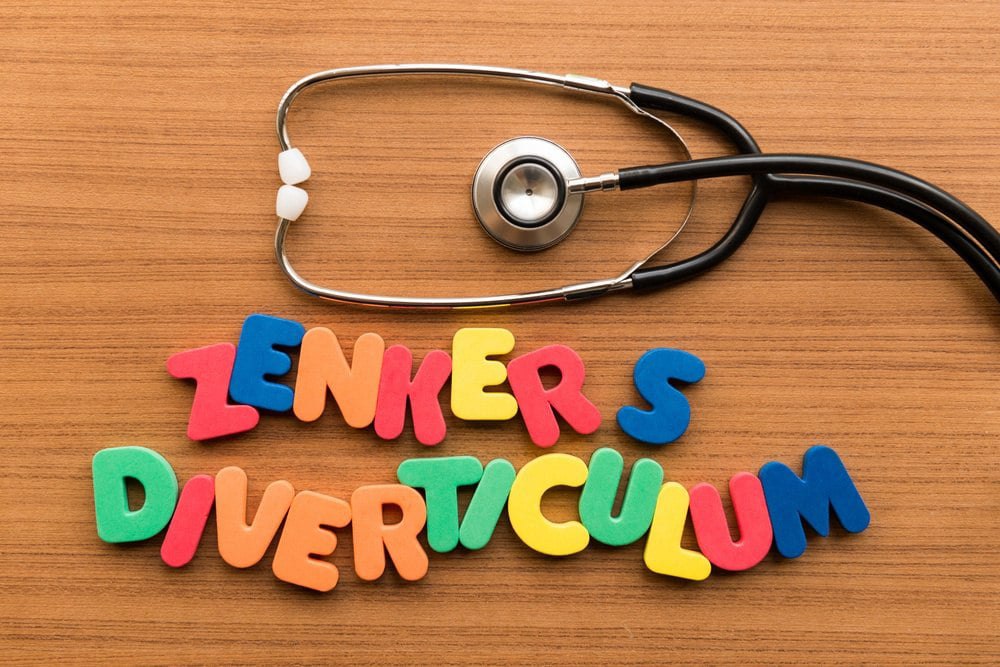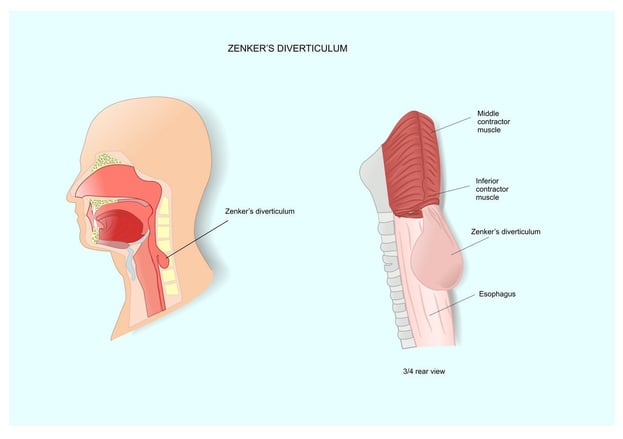What is Zenker's Diverticulum? (Causes, Signs, and Treatment)
May 25th, 2017 | 4 min. read


Swallowing is a complicated process that involves a number of nerves and muscles. Each day, the average person swallows approximately 600 times. You probably don't even think of the swallowing process until it becomes difficult to do so (dysphagia) or becomes painful (odynophagia).
With impaired swallowing, you may experience symptoms such as:
-
Gagging
-
Choking
-
Coughing
-
Drooling
There are several reasons your swallowing function becomes impaired. The causes can range from having a bone or piece of food stuck in your throat to a weakening or narrowing of your esophagus. Neurological disorders may be involved. A common reason for dysphagia, particularly in older adults, is a Zenker's diverticulum (pharyngeal pouches).
What is a Zenker’s Diverticulum?
Zenker's diverticulum is a benign, rare condition that can affect your quality of life significantly because it decreases your swallowing ability of food and liquids. With this condition, you  acquire a large sac below your cricopharynx in the upper part of your esophagus due to cricopharyngeal muscle spasms (contractions causing a lump-in-the-throat or constricted sensation).
acquire a large sac below your cricopharynx in the upper part of your esophagus due to cricopharyngeal muscle spasms (contractions causing a lump-in-the-throat or constricted sensation).
Zenker diverticulum is the most common form of esophageal diverticulum, according to the National Institutes of Health, with a 0.01 to 0.11 percent reported prevalence rate targeting mostly elderly or middle-aged patients.
Swallowing Phases
To consider how Zenker diverticulum arises, it's important you understand the swallowing process. There are three swallowing phases both voluntary and involuntary. These phases include:
1. Oral Phase: This is the voluntary stage of you swallowing and pushing food to the back of your mouth.
2. Pharyngeal Phase: This is the involuntary stage where your food is pushed down your throat from the back of your mouth.
3. Esophageal Phase: This is the involuntary stage where your food is pushed down to your stomach.
Once you initiate voluntary swallowing and move your food to your throat from the back of your mouth, the remaining part of the process happens automatically and there's no way to stop the rest of the process.
For your food to enter your esophagus from your throat, your upper esophageal sphincter (UES) needs to be relaxed. Your sphincter comprises of several surrounding muscles that include the cricopharyngeus main muscle (upper esophageal sphincter structure). When this muscle is unable to relax or there's disorder to it, this is when a Zenker diverticulum arises. Pressure is applied on your esophagus and doesn't allow food in your throat (pharynx) from getting into your esophagus correctly.
There's a buildup of pressure in your throat after swallowing and your food is being pushed. But, this throat pressure rises to a higher level as you swallow because of the disordered activity of your cricopharyngeus muscle. Over time, this causes a bulging in the upper wall of your esophagus.
Because your posterior wall (back wall) is the weakest part, the outpouching of the sac develops here and occurs more specifically in your Killian's triangle (triangular area in the wall of your throat) area that's not supported by any surrounding muscles of your esophagus.
Causes of Pharyngeal Pouch / Zenker’s Diverticulum
It's believed the primary cause of Zenker diverticulum is tightness or malfunctioning of your cricopharyngeal muscle as you age. This muscle is located right below the level of your voice box and as mentioned needs to relax while you swallow to allow your food to be pushed into your esophagus. When it fails to relax, it causes the slight bulging of your pharynx posterior wall.
Your cricopharyngeal muscle may also malfunction due to neurologic medical disorders like a stroke, for instance. The built up pressure in your lower throat causes ballooning out from the weakest portion of your pharyngeal wall that leads to a diverticulum to form that may develop several centimeters in diameter.
The combined pressure, obstruction and bulging, when repeated with repetitious swallowing, can eventually lead to Zenker's diverticulum and this keeps getting larger as more food is pressed into it.
Who Gets Zenker Diverticulum?
This condition is more prevalent in men and Northern European individuals who are in their 60s and 70s, reports the Cleveland Clinic Journal of Medicine. It hardly ever occurs before you're 40 years old and the risk of it developing increases as you age. You're also particularly vulnerable to the condition if you have a history of neurological diseases.
A radiographic study known as a barium swallow is often used to diagnose Zenker's diverticulum. During this study, the contour of the esophagus and throat is revealed by swallowing the radiopaque liquid barium. Once this liquid is swallowed, the Zenker's diverticulum is noticeable on a barium swallow on the lateral view.
Signs of Zenker's Diverticulum
This condition grows over time; therefore the symptoms may develop gradually and worsen. You might not be able to swallow at all if the pharyngeal pouch becomes too big and it can tear your esophagus in rare cases. According to the Philadelphia Temple University Hospital's medical director of the Temple Esophageal Program, Michael S. Smith, MD, if this happens, you would need medical intervention immediately and could die from severe infection.
Zenker's diverticulum symptoms may include:
-
Difficulty swallowing (dysphagia), often with a feeling of a lump in your throat. Around 90 percent of people experience dysphagia.
-
The reappearance of ingested food (regurgitation) in your mouth when food becomes trapped in the outpouching.
-
Bad breath (halitosis) due to microorganisms digesting stagnant food.
-
Coughing due to regurgitated food in your airway.
-
Lump in the neck feeling.
-
Pain .
-
Infection.
-
Involuntary gurgling noises when swallowing.
-
Cervical esophageal webs.
-
Pneumonia due to aspirated food in the windpipe.
-
Changes in voice (hoarseness).
Regurgitation often happens in the nighttime when you're lying down and can cause aspiration pneumonia or choking. It may also cause lung abscesses.
Although it's rare, 0.5 percent of diverticula patients can develop squamous cell carcinoma. This is cancer caused by uncontrolled abnormal squamous cell growth. Because it's rare, fearing cancer is not a good reason to treat diverticula surgically.
Other rare complications may include:
-
Hemorrhage
-
Ulceration
-
Vocal cord paralysis
If you have mild symptoms and minor functional limitations, you may be instructed to take a watch-and-wait approach first. You may be counseled on how to eat a bland diet and smaller amounts of food. Other ways to manage the symptoms is to chew carefully, drink water with meals, sit up while swallowing and keep your head elevated. Your doctor may consider surgical options depending on the location and if you have a more severe case.
Treatment of Zenker's diverticulum
The only treatment to cure Zenker's diverticulum is a surgical intervention, which relieves symptoms and improves the quality of life. Presently, there aren't any medications yet that treats the condition and if you leave the condition untreated, you’ll continue to have trouble swallowing which can cause malnutrition, weight loss or pneumonia as food enters your lungs from the pouch. This condition can even be life-threatening, although that's uncommon.
If you are exhibiting any of the symptoms above or suspect you have the condition, make an appointment at Houston ENT & Allergy at one of our 12 locations as soon as possible to sit down for a consultation, exam and discuss your course of treatment.
Author: Stanford Shoss, MD
Dr. Shoss holds memberships in several professional and honor societies, and has served three individual terms as Otolaryngology Section Chairman at Memorial Southwest Hospital.
Topics:
